Severe weather reinforces utility’s decision to install fiberglass poles.
By Steve Coltharp and Tim Vied, Western Kentucky Rural Electric Cooperative Corp.
After losing more than 120 wood poles to Hurricane Ike in September 2008, Western Kentucky Rural Electric Co-operative Corp. (WKRECC) installed seven RS composite utility poles in its system on a trial basis. The composite poles were quickly put to the test when, in January 2009, a once-in-a-hundred-years ice storm rolled through the WKRECC territory. The storm took down more than 1600 wood poles; yet, while the composite poles were on circuits with damaged wood poles, not one composite pole was damaged. It took weeks for WKRECC to fully restore service to its customers.
Hurricane Ike
Western Kentucky is a serene place with gently rolling hills, meandering streams and rivers, and a lot of trees. WKRECC provides electric power to 38,000 customers living in four Western Kentucky counties. The cooperative’s 100 or so employees do their best to see that 11 substations, 15 miles (24 km) of transmission lines and 4000 miles (6437 km) of distribution lines reliably deliver electric power generated and transmitted by the Tennessee Valley Authority (TVA). This is a predominantly agricultural area of the United States where things change relatively slowly. However, things changed rather abruptly when the region was hit by not one but two major weather events in less than five months.
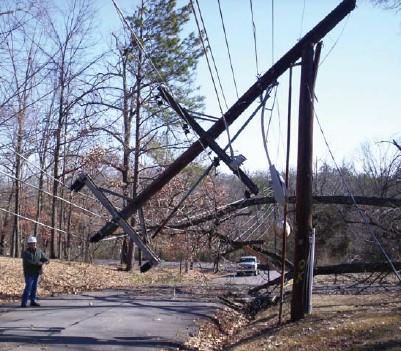
First came Hurricane Ike, which surprisingly took an interior course northward over the WKRECC service territory. The hurricane brought sustained winds of 90 mph (145 kmph), toppled thousands of trees and destroyed more than 120 wood poles, knocking out power for weeks. A utility east of the WKRECC service territory had similar issues but not with about a dozen RS composite poles it had installed near Cincinnati, Ohio, U.S. Manufactured by RS Technologies, those poles emerged from the hurricane unscathed. WKRECC took notice.
Actually, even before the storm, WKRECC has decided to purchase seven composite poles for a trial deployment. There were several primary reasons for trying out the composite poles: high strength, long life, zero maintenance, environmentally benign materials, light weight, and a modular design that makes installation easy. These benefits helped offset the somewhat-higher initial cost of the composite poles, which were about twice as much as the wood distribution poles they replaced. However, the freight costs for the composite poles were half as much as for wood poles and, according to the contractors who installed them, the composite poles were easier and faster to install, all of which saved money.
During the Ike recovery phase in October 2008, the composite poles were installed along a road not too far from WKRECC’s warehouse. The next pole in the line was steel and stood across the road near an intersection.
The Ice Storm
It did not take WKRECC long to determine the right purchasing decision had been made. On Jan. 27, 2009, a vast swath of the United States was slammed by a brutal winter storm that coated everything with a thick layer of ice. More than 1600 wood poles went down. Many of them snapped like toothpicks under the loads brought about by ice-ladened lines, or by trees and heavy branches falling against the lines. WKRECC lost its entire system, which is fed by TVA, who was down for five days before it was able to restore its transmission. However, it took WKRECC 21 days to completely restore power, and this was only possible because of the mutual assistance help of 500 cooperative volunteers from North Carolina, Alabama, Mississippi, Florida, and Tennessee.

Things got a little crowded at WKRECC’s warehouse at times during this all-hands-on-deck period of reconstruction. In addition to storing supplies, the warehouse complex was also the site for putting up the volunteers and feeding them until all the work was done.
Strength and Resilience
Amidst all of the wreckage along the road where the composite poles were installed, the only pole damaged was the steel pole with two breaks. In other words, the composites held their designed load, plus the ice, plus a portion of the load formerly carried by the steel pole across the street. This was possible because of the high amount of elastic strain energy composite poles are able to absorb in high-load situations. Needless to say, the strength and resilience of these poles in such harsh conditions were both surprising and impressive.
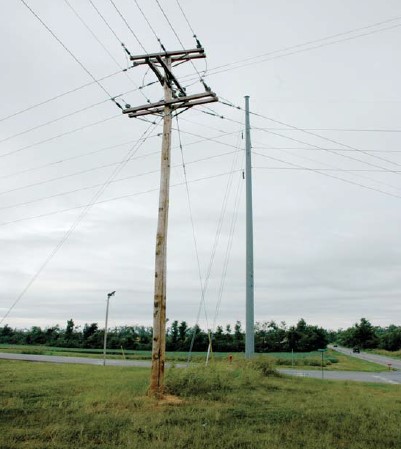
As a result of this very positive experience, WKRECC decided to install three large-diameter composite poles to carry the lines out of a new substation considered to be in a critical location. Again, the assembly and installation of these poles were quick and straightforward.
Not long after the substation project was completed in September 2009, WKRECC ordered 20 additional RS distribution poles to be part of a new 7.2-kV distribution line that is about 8000 ft (2438 m) of 397-kcmil spacer cable. The contractor’s feedback was that the lightweight composite poles were easy to handle and easy to set. The composite poles have to be drilled to fasten framing to them, and the contractor drilled these holes easily in the field. Assembly went quickly, the wire was strung, and the line was put into service soon thereafter.
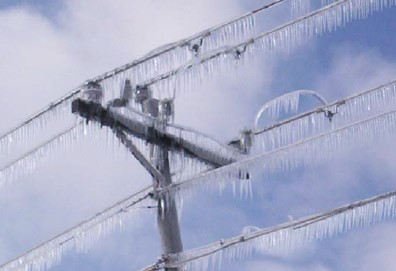
After the extreme weather events it has experienced recently, WKRECC now must consider more than just the initial capital costs in its purchasing decisions when buying poles. As mentioned earlier, shipping and installation costs with composite poles are less than that of wood poles. There is also the strength factor, which certainly plays a role in ensuring reliability and lowering maintenance costs. Unlike wood poles, composite poles do not require derating over time. In fact, their superior strength allows greater flexibility when retrofitting larger-sized conductor or for placing poles farther apart when using low-sag conductors.
Construction Pluses
Because RS composite poles are hollow, they require different installation methods and hardware. Hardware is now readily available, and linemen find hardware installation on these composite poles to be relatively easy. Holes are drilled completely through the pole, and concave mounting washers are used to distribute the stress on either side of the pole. The use of lightweight composite crossarms also makes a lineman’s job a little easier since they are much easier to maneuver high up on the pole. This also reduces the potential for back injuries and unscheduled workforce reductions. And because composite crossarms and poles are non-conductive, they have another well-appreciated safety component to them.
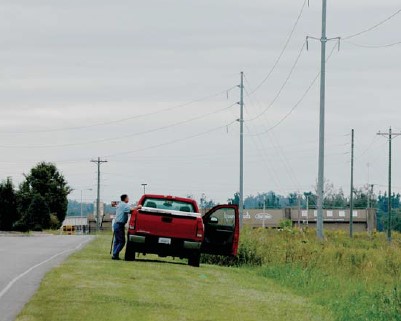
Not only do these composite poles stand up to severe weather, as WKRECC recently experienced, but they are impervious to woodpeckers, termites, and obviously wood rot because they are waterproof. Composite poles are also fire resistant and can be made extremely resistant to fire with the addition of a few coats of commercially available fire retardant. The expectation is to spend very little time inspecting composite poles in the field. Environmentally, composite poles do not have the pollution stigma or disposal problems associated with the creosote preservative on wood poles.
Then there is the issue of maintenance and emergency repair, which is no small cost consideration for any utility. The modular design of the RS poles allows the mixing and matching of various pole diameters to achieve the desired pole height. This means WKRECC can stock several modules in its inventory and have a vast variety of pole heights from those several modules. They can then be quickly deployed in the desired combination of modules to the job site on a 15-ft (5-m) truck bed without the need for a long-load transportation permit.
Another consideration is not so obvious. Because the composite poles are a modular design, utilities can even retrofit additional modules to poles in the field to increase their height, if the situation calls for greater height. For electric utilities also offering wireless broadband service, taller poles can be made from stacking more modules to serve as excellent robust transceiver platforms in existing rights-of-way.
Last, but certainly not least, is the long service life of the composite poles. If WKRECC had any reservations about purchasing these poles, they were set aside after considering the warranty and guarantee: 41-year warranty against manufacturer defects and a lifetime guarantee that states the manufacturer will replace any module or modules that fail as a result of the physical loads imposed by ice, snow, wind or lightning strikes. With a backing like that, WKRECC believed it had nothing to lose by putting these new poles in its system.
Guaranteed Performance
While it might be a natural reaction to be somewhat skeptical of a claim regarding a lifetime guarantee, any misgivings WKRECC had disappeared the day after the ice storm, and it saw how the composite poles outperformed so many of the wood and steel poles. The manufacturer standing behind its product with such a strong commitment was certainly appreciated.
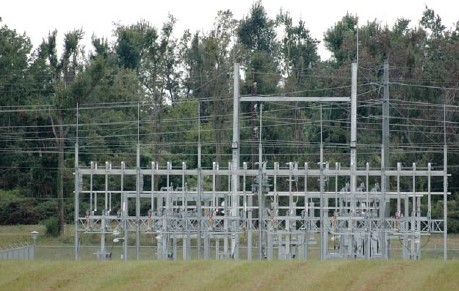
That commitment extended to the excellent service the company provided during the design, installation and fitting of the poles. The RS people went to the work site during the installation to answer any and all questions. They were easy to work with and quickly provided all the specs needed for each installation application.
The RS composite poles are excellent for applications where infrastructure must be hardened in critical, high-value locations where reliability is paramount. It may take a while for composite poles to be viewed as everyday poles, and there are several reasons for this. One is that people do not like change, and linemen and purchasers have a long history and familiarity with wood poles. Another is the costs already sunk into equipment used for installing and maintaining wood poles. Then there is the reality of operating within yearly budgets and the old habit of only considering the upfront costs of a pole rather than considering a pole’s complete life-cycle cost. One way utilities can maximize their composite pole purchases while also improving line reliability is to install a composite pole after every fifth or sixth wood pole as a preventive measure to limit cascade failures. This type of planning can greatly benefit utilities that are not only prone to ice and snow, but also those exposed to tornadoes and hurricanes.
Life-Cycle Costs
As the performance and flexibility of these modular composite poles become better known, and their long maintenance-free service life becomes more clearly evident, the old methodology for evaluating which poles to buy could certainly change. Many utilities will still be buying wood poles because the lower price of wood allows more poles to be purchased for a given amount of money. However, this type of purchasing decision comes with a significantly higher cost in line maintenance as soon as wood poles begin to show their age. The other cost is less obvious but just as real: The use of lower-cost poles comes with the realization that grid reliability is lower, as well.
As with so many business decisions, a fine line must be negotiated between affordability and reliability. By focusing on a pole’s life-cycle cost, just as is done for transformers, utilities can now get a pole product that is both affordable and significantly enhances system reliability. While composite poles may come with a premium price tag, they are the lowest-cost long-term solution after maintenance and future pole replacements are considered.
Steve Coltharp (steve@wkrecc.com) purchases all material necessary to maintain the transmission and distribution lines at West Kentucky Rural Electric Cooperative Corp. (WKRECC). He has been with the utility for nearly 20 years. He manages warehouse inventory and issues material to line crews.
Tim Vied (tim@wkrecc.com) earned a BS degree in electrical engineering technology from Murray State University in 1984. After a short stint at Florida Power & Light as a relay specialist, he moved to WKRECC, where he has worked for the past 25 years. He started as a staking engineer and was promoted to chief engineer in 1987 and again promoted to manager of engineering services in 2002.
Companies mentioned in this article:
RS Technologies www.grouprsi.com
Tennessee Valley Authority www.tva.gov
Western Kentucky Rural Electric Cooperative Corp.